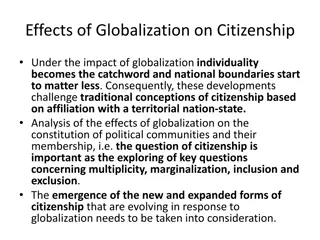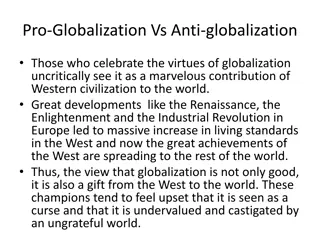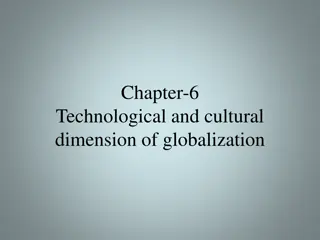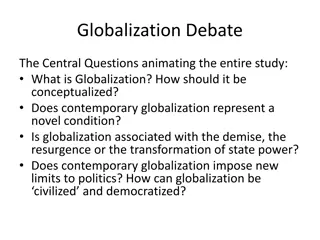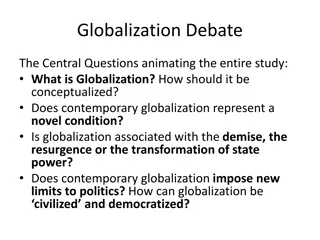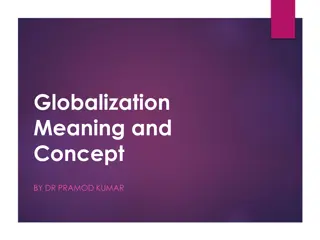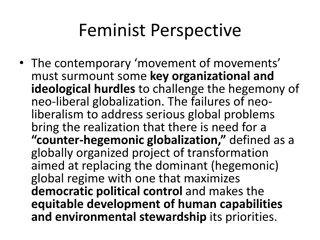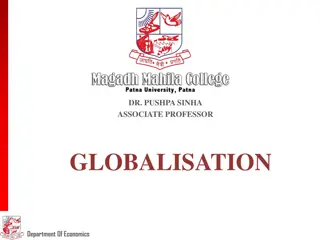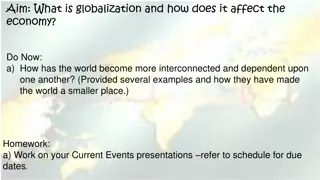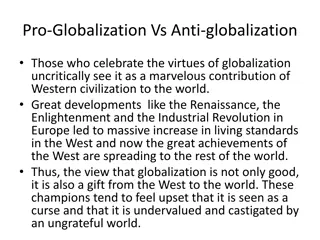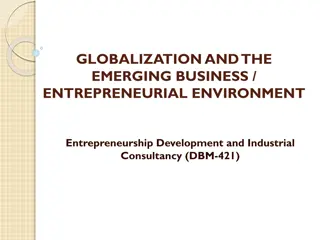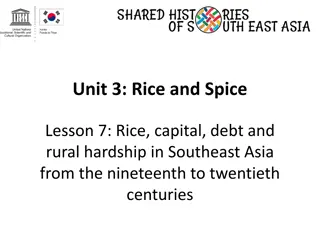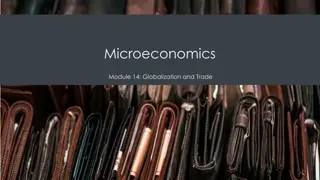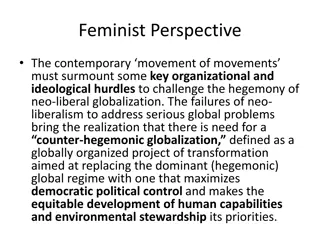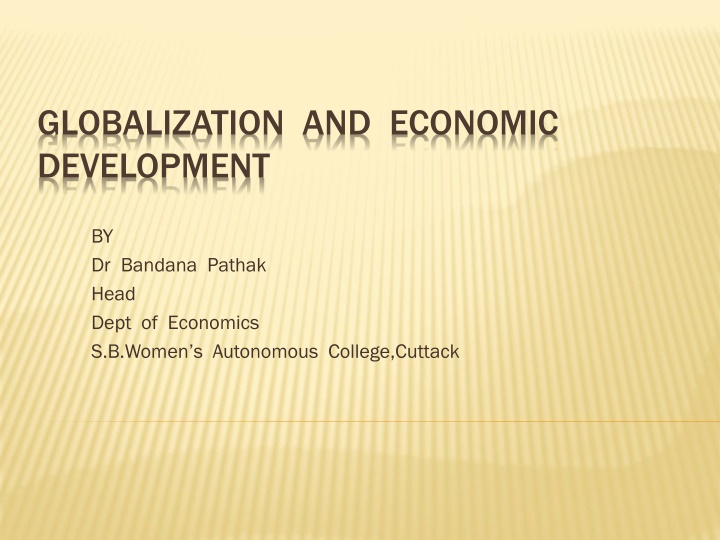
Globalization and Economic Development: A Historical Perspective
This insightful article delves into the history of globalization, tracing its evolution from ancient times to the modern era. Explore the interconnectedness of economies, cultures, and societies through the lens of trade, technology, and information exchange. Gain a deeper understanding of how globalization has shaped our world today and influenced economic development.
Download Presentation

Please find below an Image/Link to download the presentation.
The content on the website is provided AS IS for your information and personal use only. It may not be sold, licensed, or shared on other websites without obtaining consent from the author. If you encounter any issues during the download, it is possible that the publisher has removed the file from their server.
You are allowed to download the files provided on this website for personal or commercial use, subject to the condition that they are used lawfully. All files are the property of their respective owners.
The content on the website is provided AS IS for your information and personal use only. It may not be sold, licensed, or shared on other websites without obtaining consent from the author.
E N D
Presentation Transcript
GLOBALIZATION AND ECONOMIC DEVELOPMENT BY Dr Bandana Pathak Head Dept of Economics S.B.Women s Autonomous College,Cuttack
GLOBALIZATION This the word used to describe the growing interdependence interdependence of the world s economies, cultures, and populations, brought about by cross cross- -border border trade trade in goods and services, technology, and flows of investment, people, and information. Countries have built economic partnerships to facilitate these movements centuries. over many
HISTORY OF GLOBALIZATION Archaic globalization conventionally refers to a phase in the history of globalization including globalizing events and developments from the time of the earliest civilizations until roughly the 1600s. This term is used to describe the relationships between communities and states and how they were created by the geographical spread of ideas and social norms at both local and regional levels
Early modern" or "proto-globalization" covers a period of the history of globalization roughly spanning the years between 1600 and 1800. The concept of "proto-globalization" was first introduced by historians A. G. Hopkins and Christopher Bayly. The term describes the phase of increasing trade links and cultural exchange that characterized the period immediately preceding the advent of high "modern globalization" in the late 19th century.
Modern According to economic historians Kevin H. O'Rourke, Leandro Prados de la Escosura, and Guillaume Daudin, several factors promoted globalization in the period 1815 1870 The end of the Napoleonic Wars brought in an era of relative peace in Europe. Innovations in transportation technology reduced trade costs substantially.
New industrial military technologies increased the power of European states and the United States, and allowed these powers to forcibly open up markets across the world and extend their empires. A gradual move towards greater liberalization in European countries
ECONOMIC GLOBALIZATION Economic globalization Political globalization Cultural globalization
Economic globalization refers to the widespread goods, goods, capital, capital,services, services, technology economic integration and interdependence of national, regional, and local economies across the world through an intensification of cross-border movement of goods, services, technologies and capital. Economic globalization primarily comprises the globalization of production, finance, markets, technology, organizational regimes, institutions, corporations, and people. widespread international international movement technology and and information information. It is the increasing movement of of While economic globalization has been expanding since the emergence of trans-national trade, it has grown at an increased rate due to improvements in in the the efficiency efficiency of of long long- -distance distance telecommunication, telecommunication, the the importance importance of of information capital capital in in the the modern modern economy, economy, and and by technology technology. . The rate of globalization has also increased under the framework of the General Agreement on Tariffs and Trade and the World Trade Organization, in which countries gradually cut down trade barriers and opened up their current accounts and capital accounts improvements advances advances rather than than physical developments in in science transportation, transportation, information rather by developments in in physical and science and
CULTURAL GLOBALIZATION Cultural globalization refers to the transmission values values around around the the world world in such a way as to extend and intensify social relations. This process is marked by the the common common consumption been diffused by the Internet, popular culture media, and international travel. This has added to processes of commodity commodity exchange have a longer longer history history of of carrying carrying cultural cultural meaning The circulation of cultures enables individuals to partake in extended relations relations that cross national and regional borders. The creation and expansion of such social relations is not merely observed on a material level. Cultural globalization involves the formation knowledge knowledge with with which people associate their individual and collective cultural identities. It brings increasing interconnectedness among different populations and cultures. transmission of of ideas, ideas, meanings, meanings, and and consumption of cultures that have exchange and colonization which meaning around the globe. extended social social formation of of shared shared norms norms and and
POLITICAL GLOBALIZATION Political globalization refers to the growth system, system, both both in in size size and governments, their organizations as well as government-independent elements of global civil society such as international non-governmental organizations and social movement organizations. One of the key aspects of the political globalization is the declining importance of the nation-state and the rise of other actors on the political scene. William R. Thompson has defined it as "the of of a a global global political political system, system, and and its its institutions, transactions transactions (including, (including, but but certainly certainly not managed managed". Political globalization is one of the three main dimensions of globalization commonly found in academic literature, with the two other being economic globalization and cultural globalization. growth of of the the worldwide worldwide political political and complexity complexity. That system includes national governmental and intergovernmental "the expansion expansion which inter inter- -regional not limited limited to to trade) institutions, in in which regional trade) are are
EFFECTS OF GLOBALISATION Positive Effects Negative Effects
POSITIVE EFFECTS Increased trade and investment opportunities: Globalization has created new countries to trade and invest across borders. This has led to increased economic activity and higher levels of economic growth. Access to new markets and customers: Globalization has allowed businesses to expand customer customer base base and and access access new helped to boost sales and profits. new opportunities opportunities for expand their their new markets markets, which has
Greater efficiency and productivity: Globalization has increased competition among businesses, which has driven efficiency, efficiency, leading to increased productivity. Spread of new technologies and knowledge: Globalization has facilitated the spread of new technologies and knowledge allowing countries to learn from one another and adopt best practices. driven innovation innovation and and across borders,
Increased competition: Globalization has increased competition businesses, which has led to to lower quality quality produc products for consumers. Potential for economic growth and development: Globalization has the potential to drive economic growth and development, particularly particularly for countries countries that that have have been been able investment investment and and benefit benefit from increased trade opportunities. competition among lower prices prices and and higher higher for developing developing attract foreign able to to attract foreign
NEGATIVE IMPACT Loss of jobs and industries in some regions: Globalization has led to the relocation of industries and jobs to countries with lower labor costs, which has led to job losses and industry declines led to job losses and industry declines in some regions. Widening income inequality: Globalization Globalization has has increased increased income between between and and within within countries, countries, with and individuals benefiting more than others. income inequality with some some countries inequality
Cultural homogenization: Globalization has led to the spread of Western culture and values, which has resulted in the homogenization of cultures and the loss traditional traditional cultures cultures. . Environmental degradation: Globalization has contributed to environmental degradation, with increased trade and economic activity leading to higher higher levels deforestation, deforestation, and and climate climate change loss of of levels of of pollution, change. . pollution,
Dependence on foreign markets and investors: Globalization has led to increased dependence on foreign markets and investors, which can leave countries vulnerable to economic downturns downturns. . Vulnerability to global economic downturns: Globalization has increased the interconnectedness of economies, making them more vulnerable to global global economic economic downturns downturns and economic shocks shocks and and and crises crises. .
INVERTED U SHAPED CURVE Simon Kuznets
STRATEGIES FOR GOVERNMENTS AND BUSINESSES TO ADAPT TO AND TAKE ADVANTAGE OF A GLOBALIZED ECONOMY Investment in Education and Training Diversification of Industries Infrastructure Development Support for Small and Medium-sized Enterprises (SMEs) Implementation of Environmental and Social Standards Promotion of Foreign Investment 19
COLLABORATION AND NETWORKING Governments and businesses can collaborate and network with other countries and industries to share knowledge, expertise, and best practices. This can competitiveness, access new markets, and create new business opportunities. help to improve
BALANCE THE OPPORTUNITIES AND CHALLENGES OF GLOBALIZATION FOR ECONOMIC DEVELOPMENT Overall, globalization has brought about a range of both positive and negative impacts on economic development in a variety of regions and industries. Governments and businesses need to adapt to and take advantage of a globalized economy while also ensuring that they can balance the opportunities and challenges of globalization for economic development. Balancing Balancing the the opportunities opportunities and and challenges for economic development is essential for taking advantage of the opportunities of globalization while also mitigating its negative impacts on society and the environment. This balance will require a comprehensive approach that addresses the various aspects of the globalized economy. challenges of of globalization
Governments and businesses must comprehensive comprehensive inclusive inclusive economic economic growth and technological advancements, promotes sustainable development, international cooperation, invests in education and skills development, and implements effective regulatory frameworks. must utilize that that prioritizes prioritizes utilize a a approach approach growth, fosters innovation focuses on




